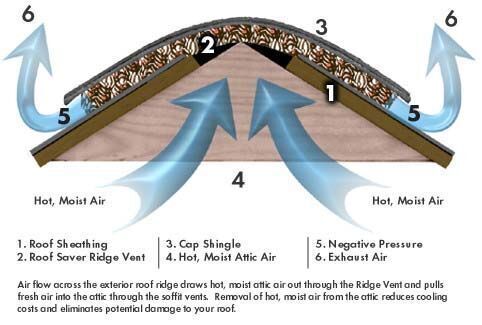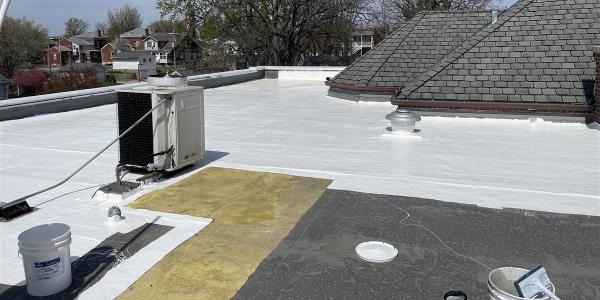Effective Attic Ventilation: Just What the Doctor Ordered

Roofing contractors can help prevent the occurrence of mold and mildew through proper attic ventilation.
By Andy Swan, Roof Saver
One the hottest topics in the construction industry and elsewhere is the adverse effect that exposure to mold and mildew can have on human health. It has recently been reported that the mold count inside a building can be as much as two to five times higher than outdoors. The key to protecting the health of residents is to minimize the occurrence of mold and mildew from the start. One important prevention method lies squarely with the roofing contractor: the proper installation of appropriate attic ventilation.
Sick Building Syndrome
There have been reports of cases in which exposure to mold and mildew has led to violent bronchial attacks, chronic sinus infections, central nervous system problems and even memory loss.
According to cec-consultants.com, the Web site of an industrial engineering consulting firm, biological contaminants also have been linked to Sick Building Syndrome (SBS). Building occupants in a “sick building” may develop health conditions that appear to be linked to time spent in the building. Research indicates that symptoms disappear when the person leaves the building. Although no specific cause of symptoms has been identified, mold and mildew have been named as one possible factor.
The challenge for contractors is that buildings typically possess all elements necessary for mold growth: mold spores, a sufficient nutrient base, a temperature of 40 to 100 degrees F and the presence of moisture.
When homeowners report mold damage to their insurance company, the company investigates the cause to determine if the damage is covered by the holder’s policy. If the cause of mold is determined to be flawed workmanship or materials, then this cause in fact points to the contractor, who is now forced to defend the claim — often without insurance coverage. Recently, some insurance companies have stopped covering mold-related damage in several states and contractors face severe liabilities.
Attic Ventilation is Key
An effective attic ventilation system can prevent moisture and control humidity, thereby minimizing mold and mildew growth. Inadequate ventilation is the cause of about 50 percent of indoor air pollution and may also cause shingles to deteriorate twice as fast. Installing shingles with improper ventilation may result in voiding the manufacturer’s warranties.
Though today’s homes are sealed more effectively from weather intrusion, moisture will still enter the home no matter how tightly sealed. A typical family can generate 2 to 4 gallons of moisture per day through routine activities such as cooking, bathing and laundry. Other daily moisture causes in the home can include flooding, leaking pipes, damp basements, and/or leaky roofs.
But moisture can also be present in buildings in its gaseous state, commonly referred to as humidity. At a 70-percent humidity level, the growth of fungi is rapid. Unfortunately, relative humidity often exceeds 70 percent indoors even when attic ventilation requirements are met. This problem is prevalent in humid climates where the outdoor relative humidity value commonly exceeds 70 percent. By controlling the indoor relative humidity between 30 and 50 percent, biological growth can be minimized.
What to Do
There are two types of ventilation: dynamic and static. Power, or dynamic, ventilation is accomplished in two ways. In homes without air conditioning, the temperature can be controlled to some extent by the use of attic fans. These fans are usually ceiling mounted in a central hallway so that outside air is pulled through open windows and exhausted through the attic. It is important to calculate the required amount and position of vents to adequately ventilate the attic.
Keep in mind, however, that power ventilation methods can add to the energy use of the home. And according to askthebuilder.com, “It turns out that rooftop and sidewall-mounted attic fans can actually suck air conditioned air from your house into your attic space.”
Static ventilation is the use of non-powered ventilation products that work with the natural flow of warm air and wind movement around the home. This method takes advantage of two principles. First, as air is heated it becomes less dense and rises. Second, wind movement over and around a home creates areas of high and low pressure. If a space has high air outlets (exhaust) in conjunction with low inlets (intake), ventilation occurs as the air within the space is heated.
Continuous ridge ventilation combined with soffit vents is the most common form of static ventilation. It provides for a total movement of air throughout the attic space. Other forms of static systems include gable vents installed at the attic wall, and turbine vents and pot vents installed near the peak of the roof that work by drawing air from the attic space.
Blocksom & Co., maker of Roof Saver ridge vents found that a system consisting of continuous ridge vents combined with soffit vents provides thorough ventilation of the attic, including air spaces that often hold stagnant air when other types of ventilation are used. Continuous ridge vents combined with soffit ventilation allow outside air to flow into the entire attic and displace super-heated and moist air. Air is always able to exit the attic and exhaust contaminants from the home. It is critical that all types of attic ventilation be designed and installed properly to prevent biological growth, especially mold and mildew.
Andy Swan is president of Blocksom and Co., manufacturer of Roof Saver Ridge Vent. For more information on Roof Saver visit www.roofsaver.com




















Comments
Leave a Reply
Have an account? Login to leave a comment!
Sign In